ASUS PQ321Q UltraHD Monitor Review: Living with a 31.5-inch 4K Desktop Display
by Chris Heinonen on July 23, 2013 9:01 AM ESTUniformity is tested by using 25 locations across the screen and measuring the color checker chart at each of them. From there we can pull out contrast, black and white uniformity, and color uniformity. This review is the first to utilize the newest measurement available in CalMAN 5.1.2: dE From Center. Now instead of measuring the dE2000 at every location, we measure it relative to the center measurement.
This gives us a true uniformity measure. I could measure the left side and the right side of the monitor and get a dE2000 of 2.0 for each side. What that doesn’t tell me is that the left side might be red tinted, and the right side blue tinted, while the center might be green tinted. In this case they could all measure the same dE2000, but look totally different. By comparing the measured values to the center, we get an actual measurement of if one area of the screen will look the same as another area. Since we always use the center of the screen as our calibration target, which is why everything is measured relative to that.
Starting out with White Uniformity, we see decent but not amazing results. The panel stays within +/- 10% for the center, but falls down to a 17% variation at the edges. The light fall-off is relatively high, and makes me wonder if the look of the panel, and its thin design, might place a bit of emphasis on style over substance.
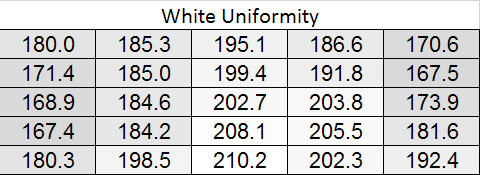

With the black level charts we see similar results. The middle of the panel is +/- 10% again, but the edges fall off to a nearly 20% difference. There is a curious rise in black level in one measure where there was a fall-off in white level, but otherwise the results between the two measurements are similar.
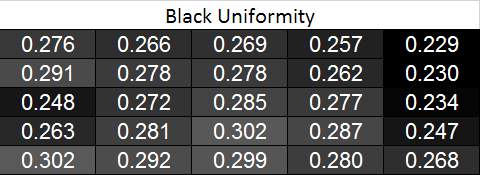
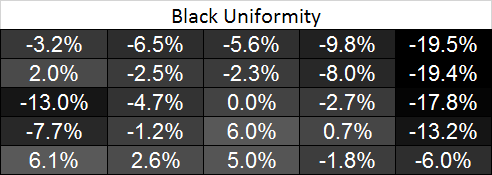
Looking at the resulting contrast, the numbers here are much closer to 100%, which we expect to see. Areas with light fall-off affect the white and black levels almost equally, so the contrast ratios are very similar all across the screen. That gives us a 700:1 expected contrast ratio for the screen as a whole.
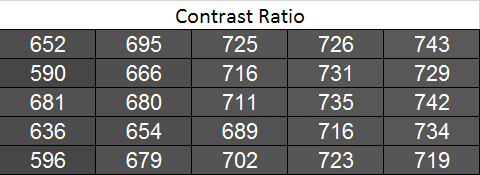
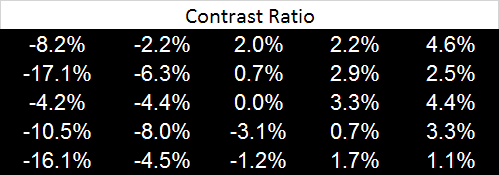
Now we can see the new dE2000 From Center data. The issues here crop up at the outsides of the screen, where we see the backlighting issues earlier. Uneven lighting is the issue most likely to cause color issues on the screen, and that is certainly backed up here. In the center of the screen, you are going to not see a difference in colors when you look directly at the screen. With a light loss of less than 10%, and a color dE2000 of <2 for most of the center screen, everything will look identical. As you get to the extreme edges you will run into more issues. I will need more monitors to be tested with this new method, but I think this is going to wind up as a good result in the end.

Going with an LED lighting system, and not a backlit array one, is always a bit of a concern for me. Overall the PQ321Q does well for uniformity for using one, and it avoids some of the massive issues we have seen with some LED systems before. But we are looking for near-perfection from the ASUS and it can’t quite do that. The center 60% of the screen is excellent overall, and for most people that will mean you may not notice these issues at all, but they are there.










166 Comments
View All Comments
cremefilled - Wednesday, July 24, 2013 - link
Even putting aside your syntax issues, almost all audio equipment depreciates in value quickly. The rare exceptions would be (the minority of) tube based amplification, and maybe a very few speakers (Quad ESL 63's).Calista - Thursday, July 25, 2013 - link
What's even worse, judging from the pictures of the homes of audiophiles the same person spending 10-20k or more on his stereo spend little to no thought on how the room effect the sound. Something we all know is incredibly important for the way sound-waves behave.cheinonen - Thursday, July 25, 2013 - link
As an audiophile as well as a video guy, I don't think the problem is that audiophiles are the worst hobbyists when it comes to paying for diminishing returns. I think the problem is that the press around audio focuses far too much on those diminishing return pieces. I'm considering writing a piece on budget phono amps, as more and more people buy turntables, but it's going to be hard. You can find 100 reviews of a $2,500 phono stage, but none of a $130 one that most people might buy. I think audio has a bad, bad marketing problem that the press reinforces.vgroo - Monday, July 29, 2013 - link
Diminishing returns is an understatement. Whenever I hear the word "audiophile", it always reminds me of those numerous sound-clarifying snakeoil products (e.g. the magnificent Bedini Clarifier, http://www.bedini.com/clarifier.htm) and the praising reviews they get around the web.Shadowself - Wednesday, July 24, 2013 - link
The low end of what anyone with any knowledge of the subject says is *easily* discernible by a person is one arc minute per pixel. (There are things like vernier acuity, rotational acuity and such that can push that by a factor of 10 or more -- to 0.1 arc minute per pixel or less.)A commonly accepted, comfortable viewing angle is 60 degrees. (Some "experts" put it at 90 degrees or more.)
Combining the minimum 1 arc minute per pixel with the minimum 60 degrees gives a horizontal pixel count of 3,600 as the minimum that the average person can easily discern given an optimum viewing distance. (If you take that to the other extreme of 0.1 arc minute and 90 degrees this becomes 54,000 horizontal pixels at the optimum viewing distance.)
So is 2160 (v) x 3820 (h) worth it to the average person with good eye sight? Absolutely. It just barely crosses the 3600 horizontal pixel count.
If you can't tell the difference between UHD (2160p) and HD (1080p) then I humbly submit you need to get your eyes checked. If you can't tell the difference between 720p and 1080p then you REALLY need to get your eyes checked.
1Angelreloaded - Wednesday, July 24, 2013 - link
No believe me playing games for long enough, on low end and high end screens def makes you more aware to PPI, in fact it is funny that most HDTVs look horrible to me, even at the optimized distance. There are things you just notice, if anything I thing being around PC for 2 long makes us somewhat sensitive just like the difference between 30fps and 60fps typically you shouldn't be able to tell a difference but as so many had said yes you can.cremefilled - Wednesday, July 24, 2013 - link
Anyone with knowledge of the subject knows that 60 Hz versus 30 or 24 Hz is easily discernible, and 120 vs 60 is also easily discernible. The confusion here stems from 24 fps being the standard for film, but the difference is that film has built-in artifacts like motion blur that make 24 Hz the bare MINIMUM for smooth motion.If you've seen IMAX presentations, you know that even for true film, 60 vs. 24 is a huge difference.
entrigant - Friday, May 30, 2014 - link
Sound is as quantifiable as video. The accuracy of each can be measured and known beyond question. It's just that nobody does it because they don't want to admit their $2000 stereo is measurably terrible despite how good they've convinced themselves it sounds.ImSpartacus - Tuesday, July 23, 2013 - link
They sit too far away ON AVERAGE.Sitting distance is a random variable and it has non-trivial variance.
I made a spreadsheet to measure this effect: http://goo.gl/dNkj6
n13L5 - Thursday, July 25, 2013 - link
I'm glad I don't have to worry about yanking $ 3.5k from somewhere, cause years of computer use has caused my 20/20 vision to weaken to the point where 1080p on a 27" screen works just fine...